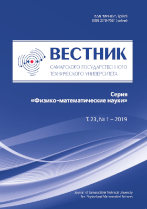|
Mechanics of Solids
Residual stress analysis in surface-hardened rotating prismatic elements with semicircular notches
under high-temperature creep
V. P. Radchenkoa, M. N. Saushkina, D. M. Shishkinb
a Samara State Technical University, Samara, 443100, Russian Federation
b Syzran’ Branch of Samara State Technical University, Syzran’, Samara region, 446001, Russian Federation
(published under the terms of the Creative Commons Attribution 4.0 International License)
Abstract:
A numerical method is developed to calculate the relaxation of residual stresses in a rotating surface-hardened prismatic sample with a semicircular notch under high-temperature creep conditions.
The problem models the stressed-deformed state of a sample fixed on a disk rotating at a constant speed.
The methodology includes the following steps:
– reconstruction of residual stress and plastic deformation fields after preliminary surface plastic deformation;
– calculation of residual stress relaxation during creep in a rotating prismatic rod.
A detailed analysis is performed on a prismatic sample measuring $150{\times}10{\times}10$ mm made of EP742 alloy. One face of this sample is hardened using mechanical ultrasonic treatment.
The problem is analyzed for samples with semicircular notches of 0.1 mm and 0.3 mm radii, located 2 mm and 75 mm from the fixed edge.
For the notched regions after preliminary surface plastic deformation, the problems are solved in both elastic and elastoplastic formulations. The obtained initial fields of residual stresses and plastic deformations are used as input data for the creep problem.
The analysis of the influence of notch radius, location, angular velocity, and initial residual stress fields on the relaxation of residual stresses is conducted at a temperature of 650 ${}^\circ$C based on phenomenological flow theory established from known experimental data for this alloy.
Results show that to determine the initial stressed-deformed state after preliminary plastic deformation for a notch radius of 0.1 mm, an elastoplastic solution is necessary, while for a radius of 0.3 mm, the differences between elastic and elastoplastic solutions are minimal.
The study of residual stress relaxation is conducted at angular velocities of 1500 and 2000 RPM over a period of 100 hours. Despite significant relaxation of residual stresses for samples with notches of radii 0.1 mm and 0.3 mm, a substantial level of residual compressive stresses remains in the notch regions after complete thermal-mechanical unloading. This indicates the high effectiveness of surface hardening under high-temperature creep conditions.
Keywords:
residual stresses, preliminary surface plastic deformation, semicircular notch, rotation of prismatic specimen, creep, relaxation of residual stresses
Received: June 18, 2024
Revised: October 12, 2024
Accepted: October 21, 2024
First online: November 21, 2024
Citation:
V. P. Radchenko, M. N. Saushkin, D. M. Shishkin, “Residual stress analysis in surface-hardened rotating prismatic elements with semicircular notches
under high-temperature creep”, Vestn. Samar. Gos. Tekhn. Univ., Ser. Fiz.-Mat. Nauki [J. Samara State Tech. Univ., Ser. Phys. Math. Sci.], 28:3 (2024), 489–515
Linking options:
https://www.mathnet.ru/eng/vsgtu2099 https://www.mathnet.ru/eng/vsgtu/v228/i3/p489
|

| Statistics & downloads: |
| Abstract page: | 147 | | Full-text PDF : | 46 | | References: | 23 |
|




 Contact us:
Contact us: Terms of Use
Terms of Use
 Registration to the website
Registration to the website Logotypes
Logotypes









 Citation in format
Citation in format 